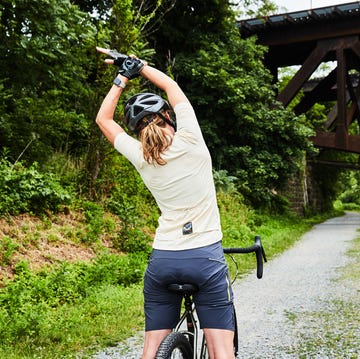If you look down at your phone or laptop almost all day every day, there’s a good chance you occasionally experience neck pain or what some experts refer to as “tech neck.”
This pain and posture issue is especially prevalent among cyclists because they also hold a forward-leaning position in the saddle, reinforcing neck misalignment, physical therapist Brando Lakes, D.P.T., orthopaedic certified specialist and co-founder of Kinesadelic in New York City tells Bicycling. Tech neck, says Lakes, is “very problematic.”
Fortunately, there are easy ways to fix tech neck, including posture changes and exercises.
Ahead, everything you need to know about fixing tech neck, including what the term actually means, why it’s bad, and expert-backed advice for remedying the pain associated with it.
What is tech neck?
Tech neck is a generalized term for neck pain and tightness that is associated with the posture we maintain as we look at screens, phones, tablets, and computers, physical therapist Elizabeth Lamontagne, P.T., D.P.T., assistant director at Recovery Physical Therapy in New York City tells Bicycling.
Your head weighs anywhere from 10 to 12 pounds, and when you bend it forward at a 45-degree angle, that increases the amount of force on the neck to nearly 50 pounds, according to UT Southwestern Medical Center.
Holding that much weight on the neck for a long time—or about five to six hours a day, which is the average time an American spends on their phone, according to Statista—all the muscles that support the head can get tight on one end and overstretched on the other, explains Lamontagne. This, in turn, can cause muscle spasms and a whole host of other issues.
Unfortunately, most of us will likely experience tech neck at some point. It’s “pretty common,” says Lakes. “If you have a phone, there’s a good chance you’re gonna get tech neck.”
Why should you work to fix tech neck?
If left untreated, tech neck can lead to semi-serious complications, says Lamontagne. For example, if your neck muscles get so tight that it doesn’t feel good to sit up straight, you might continuously sit in a hunched position and let your shoulders droop forward. The more your shoulders curve forward, the less space there is for your nerves. This could further exacerbate your pain and potentially pinch a nerve, Lamontagne explains.
Moreover, the pain can travel. So instead of just feeling pain in your neck, you may experience it in your shoulder, too, or in your head, says Lamontagne.
Additionally, tech neck can cause headaches, as well as numbness or tingling that extends down the arms into the fingers, says Lakes. If you feel numbness in your hands or fingers while you ride, it could be from tech neck, though it could also be caused by a nerve in your wrist getting compressed from the way you grip the handlebars, explains Lakes.
Tech neck can also make it easier for you to get whiplash and cause other unpleasant issues like carpal tunnel, shoulder impingement, and tennis elbow, he adds.
Now, tech neck won’t lead to anything severe enough to drive you to the emergency room, says Lamontagne. But, she adds, you may just end up going to the doctor because of unrelenting pain.
On that note, if your tech neck symptoms don’t resolve within a week, and doing gentle stretches or applying heat to the area doesn’t help, then you should probably see a doctor or physical therapist about the issue, says Lamontagne. If you feel persistent or progressive numbness, tingling, or weakness, that also means it’s time to see your doctor.
Additionally, remember that if one side of your body is tight because you look at your phone or laptop consistently in one particular position, you can create an imbalance in your body. This can ultimately affect your performance on the bike.
How do you prevent tech neck?
You’ve heard this before but it’s so important to remember: If you work a sedentary job, set a goal to get up every 60 minutes so that you’re not in the same position for more than an hour, says Lamontagne. Taking even a moment to get a glass of water, go to the bathroom, or do a quick stretch can help.
You can also look into getting your desk set up ergonomically, which can help improve your posture. If you use a laptop, the screen should be at eye level. You may need external keyboard, so you don’t have to hold your arms at an uncomfortably high angle to type, is helpful.
If you use two screens, consider switching to just one wider monitor so you won’t have to turn your head back and forth at weird angles.
It can also help to have a desk that’s set to the height of your elbows when you’re sitting and your elbows are bent at a comfortable 90- to 100-degree angle, says Lamontagne. Standing desks, set to elbow height when you’re standing, are another good option, she adds.
You may also consider a device called Upright GO, which is essentially a necklace that vibrates whenever you slouch or jut your head forward, explains Lakes. Or a posture corrector, which is worn like a backpack and helps pull your shoulder blades together. “It's kind of hard to allow that head to come forward when those shoulder blades are being pulled back,” says Lakes.
How do you fix tech neck?
Consider self-massage of trigger points (areas that feel especially tight or tender compared to other areas) to help relieve the tension in the neck and shoulders, suggests John Vasudevan, M.D., associate professor of clinical physical medicine and rehabilitation at the University of Pennsylvania and codirector of the Penn Medicine Running and Endurance Sports Program. To do this, put pressure on the spot for 20 to 30 seconds to the point where “discomfort meets pain,” he says. It also helps to do this while you’re stretching the muscle at the same time you massage it.
Aim to do this two to three times per day for two to three weeks. If you can’t reach the tense spot with your own hands, consider using a Theracane or Body Back Buddy to reach the site.
In addition to the above tips, there are simple exercises you can do to fix tech neck or prevent the aches associated with it. Below are two sequences—the first sequence is from Lakes; the second is from Lamontagne—that loosen muscles and allow you to reset your posture so you don’t get pinched nerves or muscles spasms.
How to use this list: These moves are gentle so you can do them every day. Do each exercise for the number of reps and sets listed below. You’ll need a resistance band and foam roller for the first sequence.
Sequence 1
Standing Bicep Stretch
Stand in front of and facing a wall and place right hand on the wall at shoulder level. Extend arm and place palm completely flat against wall with fingers pointing right. Now, turn entire body to the left, and feel a stretch from right fingers all the way up to right shoulder. Drop left ear to left shoulder to intensify the stretch. If you feel numbness or tingling, curl fingers or take palm off the wall and form a fist instead. Hold for a minimum of 30 seconds, or as long as it feels good. Switch sides and repeat.
Shoulder Ts
Stand with feet hip-width apart, hold a resistance band in both hands with arms extended directly in front, at shoulder height. (You can grip the band with palms up or down, depending on what feels good to you.) This is the starting position. Pull the band apart to squeeze shoulder blades together. Hold, then gently release to return to the starting position. Repeat. Do 3 sets of 10 reps.
Foam Roller Extension
Lie faceup with a foam roller positioned horizontally across spine near shoulder blades. Cup head with hands and glue hips to the floor. Allow gravity to gently carry head and shoulders over the foam roller. Hold for a minimum of 30 seconds, or however long feels good.
Sequence 2
Standing Wall Stretch
Stand against and facing away from a wall so that head, upper torso, and hands are touching the wall, arms down by sides. (Aim for backs of hands against the wall, but see how palms feel against the wall, too.) Position feet slightly away from the wall. Set shoulders back against the wall and open up chest. Hold for 5 to 10 seconds. Release. Then repeat 1 or 2 more times.
Upper Trapezius Stretch
From a standing or seated position, drop right ear towards right shoulder and hold for 20 to 30 seconds. You should feel a gentle stretch on the left side of neck. Repeat, dropping left ear to left shoulder. Hold for 20 to 30 seconds. You can gently place opposite hand on head to deepen the stretch.
Pec Doorway Stretch
Stand in front of a doorway and bring arms into a goal post position with fingers pointed up and elbows bent to 90 degrees. Place forearms on either side of the doorway and step one foot forward until you feel a stretch in chest. Hold for 20 to 30 seconds, then switch stance so the other foot is forward and repeat for another 20 to 30 seconds. You can also do this one side at a time against a wall (as shown).
Subscapularis Doorway Stretch
This stretch is similar to the one above, but instead of goal post position, keep elbows in at sides. Extend forearms straight out from elbows with palms facing forward. Place both palms on either side of the doorway and step through with one foot until you feel a gentle stretch in rotator cuff. (You may also feel a light stretch in chest.) Hold for 20 to 30 seconds, then switch stance so the other foot is forward and repeat for another 20 to 30 seconds. You can also do this one side at a time against a wall (as shown).
.John Vasudevan, M.D. is an associate professor at the University of Pennsylvania. He is board-certified in Physical Medicine & Rehabilitation and Sports Medicine. He is a Team Physician for UPenn Athletics and medical director of the Broad Street Run and Philadelphia Distance Run, and previously for the Rock 'n' Roll Half-Marathon and Tri-Rock Triathlon in Philadelphia. He is a director of the running and endurance Sports Medicine Program at Penn Medicine. Dr. Vasudevan provides non-operative management of musculoskeletal conditions affecting athletes and active individuals of all levels, and combines injury rehabilitation with injury prevention. He utilizes a variety of ultrasound-guided procedures and regenerative approaches such as platelet-rich plasma and percutaneous ultrasonic tenotomy. He sees patients at the Penn Medicine and the Philadelphia Veterans Administration hospital. Dr. Vasudevan attended medical school at the University of Wisconsin School of Medicine and Public Health in Madison. After his Transitional Year in Tucson, Arizona, he went to residency in PM&R at Thomas Jefferson University in Philadelphia and onwards to Stanford University for his fellowship in Sports Medicine. He has been in practice at the University of Pennsylvania since 2012.




















